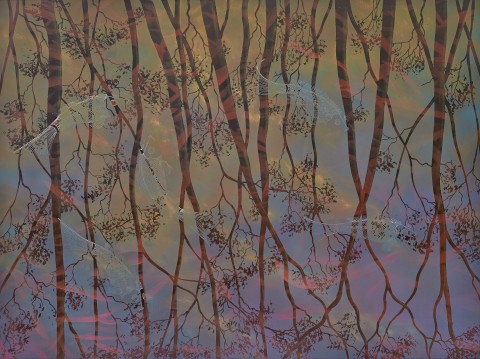DAWN AT NUMERILI, 1993
LIN ONUS
synthetic polymer paint on canvas
91.0 x 121.5 cm
signed lower right: Lin Onus
Gallery Gabrielle Pizzi, Melbourne, 1993 (label attached verso)
Private collection, Melbourne
Susan McCulloch, Melbourne
Caruana and Reid, Sydney (as ‘Dawn at Numillah’)
Private collection, Melbourne, acquired from the above in 2004
Lin Onus: There and Back: An Exhibition of Recent Paintings and Sculpture, Gallery Gabrielle Pizzi, Melbourne, 15 July – 17 August 1993
Lin Onus, Gallery Gabrielle Pizzi at ARCO 94, Madrid, Spain, 1994 (as ‘Nubes Juntándose, 1993; de la Serie 24 horas en Numerili’ (Clouds Gathering, 1993; from the series 24 hours at Numerili))
In Lin Onus’ retrospective catalogue, Urban Dingo: The Art and Life of Lin Onus, curator Margo Neale chronicles that from 1986 – 96, he made sixteen ‘spiritual pilgrimages’ to the outstation of Gamardi, the home of his mentor Jack Wunuwun in Central Arnhem land.1 Having first met Wunuwun at Maningrida in 1986 while travelling in his role as the Victorian representative for the Aboriginal Arts Board, his life’s direction from that moment was deeply influenced by this encounter with the late Yolngu elder and artist, who had adopted him as his own son.
Although Onus had explored a range of imagery relating to dispossession, he described himself primarily as a landscape artist until 1986, when he began to title his works using the language of his adoptive family, and his work developed into a combination of images of land depicted in Western style incorporating Aboriginal imagery and stories. Wunuwun was able to offer Onus a kind of cultural sanctuary by welcoming him into the Yolngu kinship system. This relationship provided Onus with the opportunity to learn Aboriginal traditional knowledge, which enhanced his own Yorta Yorta experience of the world. Through Wunuwun, Onus was given creation stories that he was permitted to paint and an Aboriginal language he could also access. Onus acquired his knowledge of symbols, patterns and designs from the community elders and it seemed to him that this experience of tradition was ‘like a missing piece’ of a puzzle which ‘clicked into position’ for him culturally.2
From a series of 1993 paintings titled 24 hours at Numerili, recording the same site at different times of the day, Dawn at Numerili, is a striking example of Onus’ multilingual visual language. Painted after an annual journey to visit Wunuwun at Gamardi, this work depicts the interplay between Aboriginal and non-Aboriginal visual languages. Here are photo-realistic images of a billabong, where reflected tall trees emerge in the dawn light and five fish glide just below the surface of the water, affording glimpses of the traditional markings that cover their bodies. Details such as these convey the sense that the artist spent hours observing this setting.
Luminous, hypnotically beautiful and multi-layered in meaning, Onus’ paintings claim ownership of the land while subverting the primacy of western modes of representation. They present a duality that Robert Nelson has described as a form of symbolic realism, noting Onus’s ability to use both the traditional idiom of perceptual art in the landscape tradition, together with fish, frogs and reptiles painted according to Aboriginal conventions.3
Lin Onus hoped that ‘history would see him as some sort of bridge between cultures’4 and as articulated by Ian Mclean, ‘[he] successfully used postmodern strategies to infiltrate issues of Aboriginality into everyday Australian life’5. The convergence of two visual perspectives reflects Onus’ personal and artistic journey. The trees that populate the billabong here are reflected in the cool dark water and its hidden depths suggest unknown worlds and new possibilities. His cross-cultural imagery defies immediate categorisation and leads to a wider discussion and expansion of the space occupied by Aboriginal art.
1. Neale, M., Urban Dingo: The Art of Lin Onus 1948–1996, Queensland Art Gallery, Brisbane, 2000, p. 15
2. Leslie, D., ‘Coming home to the land’, Eureka Street, March – April 2006, https://www.eurekastreet.com.au/article/coming-home-to-the-land#, accessed 22 September 2020
3. Neale, op. cit., 2000, p. 16
4. Ibid, p. 21
5. McLean, I., ‘One mob, one voice, one land: Lin Onus and indigenous postmodernism’ in Neale, M., Urban Dingo: The Art of Lin Onus 1948 – 1996, Queensland Art Gallery, Brisbane, 2000, p.41
CRISPIN GUTTERIDGE
